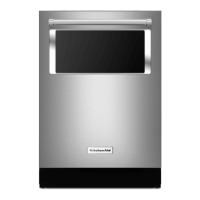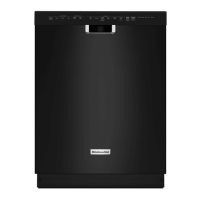6-8
n
KitchenAid 2015 Microltration Dishwashers
TESTING
For Service Technician Use Only
DANGER
Electrical Shock Hazard
Only authorized technicians should perform
diagnostic voltage measurements.
After performing voltage measurements,
disconnect power before servicing.
Failure to follow these instructions can result in
death or electrical shock.
Fill Circuit
This test will check the wiring and components in the ll
circuit. The following items are part of the ll circuit.
n Harness/Connecon
n Overll Switch
n Fill Valve
n Control Board
Test Procedure
1. Verify water supply is turned on and supply line
is adequate. Check for water siphoning out of the
dishwasher (drain loop or improper drain connecon).
Check for debris in water line or ll valve inlet screen.
Check for proper oat switch operaon. Repair as
necessary.
2. Are all the loads controlled by TRIACs not working?
¾ YES – check for open door switch, TRIAC fuse, or pilot
relay.
¾ NO – just the Fill Valve. Go to step 3.
3. Unplug dishwasher or disconnect power.
Strip Circuit – Fill Valve
4. Remove toe and access panels to access control board.
5. Unplug connector P6 from control board.
6. Check the ll valve and harness—using an ohmmeter,
measure the resistance between P6-7 and P6-9.
¾ If the resistance is between 890-1090 ohms, the ll
valve and harness are good. Go to step 7.
¾ If outside the range, replace the ll valve.
¾ If an open circuit is detected, check connecons and
harness connuity between control and ll valve. If
good, replace the ll valve.
7. Check the oat (overll) switch—using an ohmmeter,
measure the resistance between P6-4 and P6-6 with the
oat switch closed/oat down (normal posion).
¾ If 3 ohms or less is measured, go to step 8.
¾ If an open circuit or high resistance is measured, check
connecons and harness connuity between the
control and oat switch. If harness is good, replace
switch and retest.
8. Using an ohmmeter; measure the resistance between
P6-4 and P6-6 with the oat switch open/oat up.
¾ If reading is innite, go to step 9.
¾ If 3 ohms or less is measured, or oat/overll switch is
damaged, replace switch and retest.
9. Reconnect P6 to control board.
10. Set voltmeter to AC and connect leads to test-pads P10-
1 & P6-9 on the control board. Plug in dishwasher or
reconnect power.
11. Start the Diagnosc Cycle and at the proper interval
measure for AC out of the control between test-pads P10-
1 & P6-9. (Refer to the Fill Valve Strip Circuit below.)
IMPORTANT: The Fill Valve must be connected to the
control board to measure voltage accurately!!!
¾ If no AC voltage is measured, replace the control board
and retest.
¾ If 120V AC is measured and ll valve is energized, go to
step 12.
12. Unplug dishwasher or disconnect power.
13. Reassemble all parts and panels.
14. Plug in dishwasher or reconnect power and run Diagnosc
Cycle to verify repair.
4
Control Pinout
Meter Check of Loads and Fuses
Dishwasher Strip Circuits
The following individual circuits are for use in diagnoses. Do not continue with
the diagnosis of the appliance if a fuse is blown, a circuit breaker is tripped, or if
there is less than a 120-volt power supply at the wall outlet.
■ Unplug dishwasher or disconnect power.
■
Perform resistance checks. To check resistance of a component,
disconnect harness leads first.
Door Switch
Wash/Rinse
Water Heating/Heat Dry and Water Sensing with O.W.I. Sensor (Water/Air/Soil/Temperature)
Pump is washing. Control monitors temperature during water heating periods. See “Wash/Rinse” and “Water Sensing with O.W.I. Sensor (Water/Air/Soil/
Temperature)” circuits.
Fill
(Top)
W2
P5
P6
P7
P8 P9
P10 P11
P12
P13
-4
-3
-2
-1
-2
-1
-1
-6
-9
-1
-6
-1
-6
-1
-5
-6
-1
-3
-5
-1
-2
-4
-6
-1
-3
(OWI)
P12 (Wide Out)
P13
P4
P5
P6
BR
P7
BU
P8
RD
P9
V
P10
BR
P11
RD
P12
YL
Ω of F9 Triac Fuse
Electronic Control
Electronic Control
Micro PinMicro Pin
Micro PinMicro Pin
K4
Motor (N) Relay
K3
Heater (L1) Relay
K2
Pilot (L1) Relay
K1
Heater (N) Relay
N.O. N.O. N.O. N.O.
(To Wash Motor)
(To Heater)
(To Wash Motor,
Vent, and Triac Loads)
(To Heater)
N.O.
Door
Switch
Sensing
Input
Ref
P9-5
P10-4
Door
Switch
P9-6
13V
VV
Motor Power
BK
N.O.
TURQ
(LBU)
K2
Pilot L1 Relay
(Also see Door
Switch Circuit)
Electronic Control
P4-2
P5-2
Pin 3
Pin 2
K4
Motor N Relay
(Also see Door
Switch Circuit)
WH
P5-1
P4-1
Sense Resistor
or Jumper
0
Ω
N
L1
V
Y
Y
AUX
Winding
6
Ω
- 10
Ω
CAP
23.5 µF
Run
Winding
3
Ω
- 7
Ω
Motor and Capacitor
(Wash Pump)
120V, 60 Hz, 190W typical
TURQ
(LBU)
Electronic Control
N.O.
L1
BK
Electronic Control
N.O.
K3
Heater L1 Relay
(Also see Door
Switch Circuit)
Hi-Limit
Thermostat
Opens
207°F - 217°F
(97°C - 103°C)
Heater Element
8
Ω
- 30
Ω
120V, 60 Hz
785W Wet
500W Dry
N.C.
P4-2
P4-3
P4-4
P4-1
N
Electronic Control
N.O.
K1
Heater N Relay
(Also see Door
Switch Circuit)
Electronic
Control
P12-6
P12-5
P12-4
P12-3
P12-2
P12-1
Pin 1
Pin 2
Pin 3
Pin 4
Pin 5
Pin 6
Measure NTC resistance at P12-1 and
P12-3 connector disconnected from control.
Turbidity Drive
Foam Drive
OPT Sig
VCC
Ref
NTC
O.W.I. Sensor
Temperature: NTC Thermistor
46K
Ω
- 52K
Ω
at 77°F (25°C)
11K
Ω
- 13K
Ω
at 140°F (60°C)
Heater
BU/RD BU/RD
BU/WH
WH
YL
YL
YL
YL
YL
YL
L1
BK
P4-2 P6-4
P10-1
P6-6
P6-7
P6-9
P4-1
Use top hole of jumper
W2 as test point for F9.
N.O.
K2
Pilot L1 Relay
(Also see Door
Switch Circuit)
Fuse
F9
Electronic Control
Electronic Control
Float
(In normal position,
holds switch closed.)
BR
BR
N.O.
Pin 3 Pin 1
Overfill
Float Switch
No test pad on P6-4.
Recommend using test pad on P10-1.
No test pad on P6-7.
Recommend using test pad on P6-6.
Electronic Control
Float Switch
Input
BR
BR
Pin 3 Pin 1
Triac
Fill Valve
890
Ω
- 1,090
Ω
120V, 60 Hz, 6W
WH
N

